This is part 5 of my “Uganda- The Pearl of Africa” series, the one where we visit Queen Elizabeth and Lake Mburo National Parks. Read the first 4 parts here, where we visit Entebbe, Lake Bunyonyi, Bwindi Impenetrable National Park, and Mbarara. See pix from our trip here.
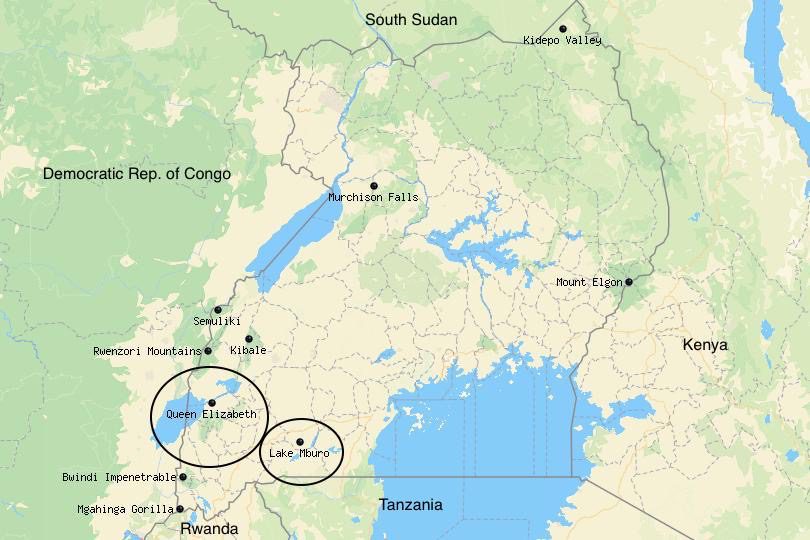
Queen Elizabeth National Park
Queen Elizabeth National Park is located in Southwestern Uganda and is one of 10 national parks in that country. It is one of only two places where you can see tree-climbing lions, the other being Lake Manyara National Park in Tanzania. Read about my time at Lake Manyara here.
The Drive
Lucas picked us up for the three hour drive from Mbarara to Queen Elizabeth National Park. It was a beautiful drive, taking us from the idyllic countryside into mountains divided by expansive valleys. We drove through banana groves and villages, and past tea plantations. Larger companies would pay smaller businesses to advertise for them. These advertisements consisted of large, colorful murals painted on the sides of buildings, and the advertisers included “Africell,” Kampala Concrete, and a dry milk factory. The murals, coupled with the vibrant fabrics of locals’ clothing and the spectrum of natural colors of fruit for sale in the markets, made the villages extremely colorful.
Vendors selling fruit, rolexes, and goat skewers from their push carts lined the streets within villages, and there were random piles of trash. Goats and cows grazed in the grass by the road, corralled by their minders and gnawing grass. We sampled the goat, as well as a popular Ugandan snack called “Gonjo,” a type of plantain served grilled, that tasted like an undercooked sweet potato.
Approaching the Park
As we began to ascend, the road deteriorated. As the road became worse, the views became better. We could see Lake Edward at one point, which is a large lake that sits on the border of Uganda with Congo. For a short period of time, it was renamed Lake Idi Amin, but it regained its maiden name after this evil dictator was overthrown. The Kazinga Channel connects Lake Edward to Lake George, which will become important later in this story.
We could see the beginnings of the Virunga Mountains, a volcanic mountain chain, and the Rwenzori Mountains, both bordering the DRC. The latter are also known as the “Mountains of the Moon” for their semilunar shape, and were once thought to be the origin of the Nile River. The Albertine Rift, a branch of the East African Rift, runs under these mountain ranges and is part of the western African Rift Valley. It is complicated, but very basically the Albertine Rift is part of a “divergent tectonic plate boundary,” where the African tectonic plate is splitting in two. You can begin to nerd out about this here.
Game Drive in the Park
Upon arrival, we picked up a park ranger and went out for a late afternoon game drive. The best wildlife viewing tends to be in the early to late morning and early evening, as well as after dark. Animals tend to hunker down during the heat of the day, and many are nocturnal and best seen at night.
Ugandan kobs were plentiful. These are tan-brown colored antelope common in the area and featured on the Ugandan flag, along with the crested crane. The mating habits of the kobs are very interesting. Males of the species arrange themselves in a traditional mating ground called a “lek,” where they display their best features and hang out. Females come by and browse the goods on display, making their choices based on features they think will signify a successful mate.
The “Lek mating system” is great for the females! The term “lek” is derived from a Swedish noun which typically denotes “pleasurable and less rule-bound games and activities.”
Elephants and warthogs were plentiful and provided entertainment for us. A territorial, greedy park ranger on a motorcycle guarded the lion pride, charging a bribe to allow vehicles close to them. This is illegal, but still occurs.
We watched the sun set over the Mountains of the Moon, which was a spectacular light show. As we were about to pull into the gate of our safari camp for the night, we saw a dark shape on the side of the road which started to move. It was a black mamba! We stopped and watched this massive, deadly creature race across the road and disappear into the bush.
Mweya Safari Lodge
If you are visiting Queen Elizabeth National Park in Uganda, I cannot recommend Mweya Safari Lodge strongly enough! On the banks of the Kazinga Channel and surrounded by the Mountains of the Moon, this is your quintessential safari lodge. Dr. Livingstone could only imagine such a place! Nearby is the Uganda Wildlife Authority Information Center where you can learn about the local flora and fauna.
The main lodge had soaring ceilings, expansive windows, and heavy, brown leather and warm wood furnishings. The decor was dominated by elephants- paintings, carvings, and sculptures.
Our “Classic Tent”
After check-in, the porter drove us in a golf cart to our “classic tent” overlooking the Kazinga Channel. It was amazing, much like safari tents I have stayed at in Tanzania and Botswana- posh, yet slightly rustic. Safari chic. These tents are basically like private villas, but with canvas walls so you can hear all the sounds of Africa.
Situated on top of a hardwood platform, we accessed the tent by a few stairs. It consisted of a bedroom with king-sized bed surrounded by mosquito netting, a seating area, and a bathroom with two sinks, a huge shower, and a toilet with a bidet. The highlight for me was the massive deck overlooking the water, furnished with a couch, table, and rocking chairs. I enjoyed sitting on that deck, writing in my journal.
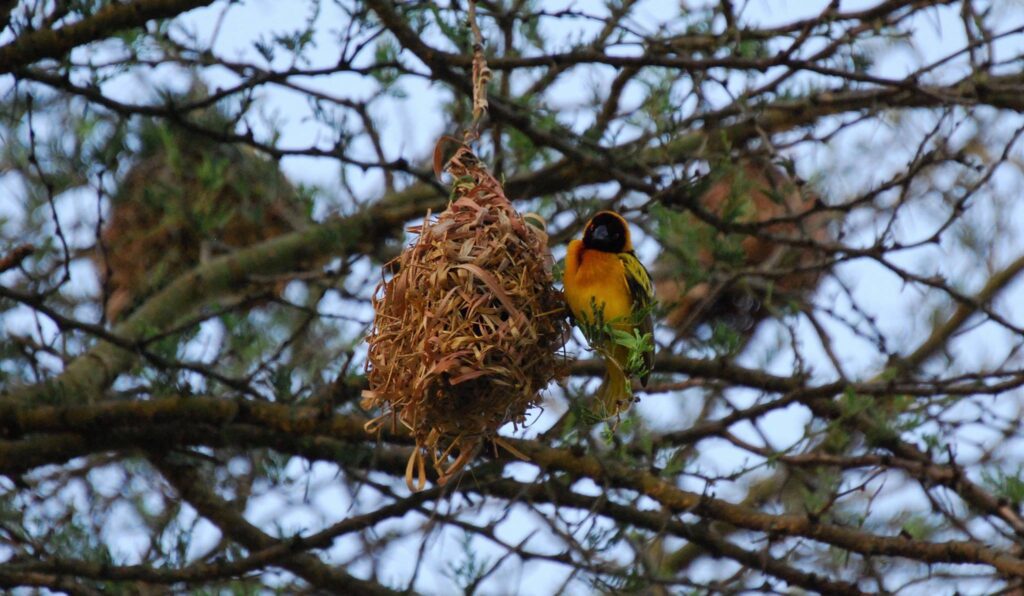

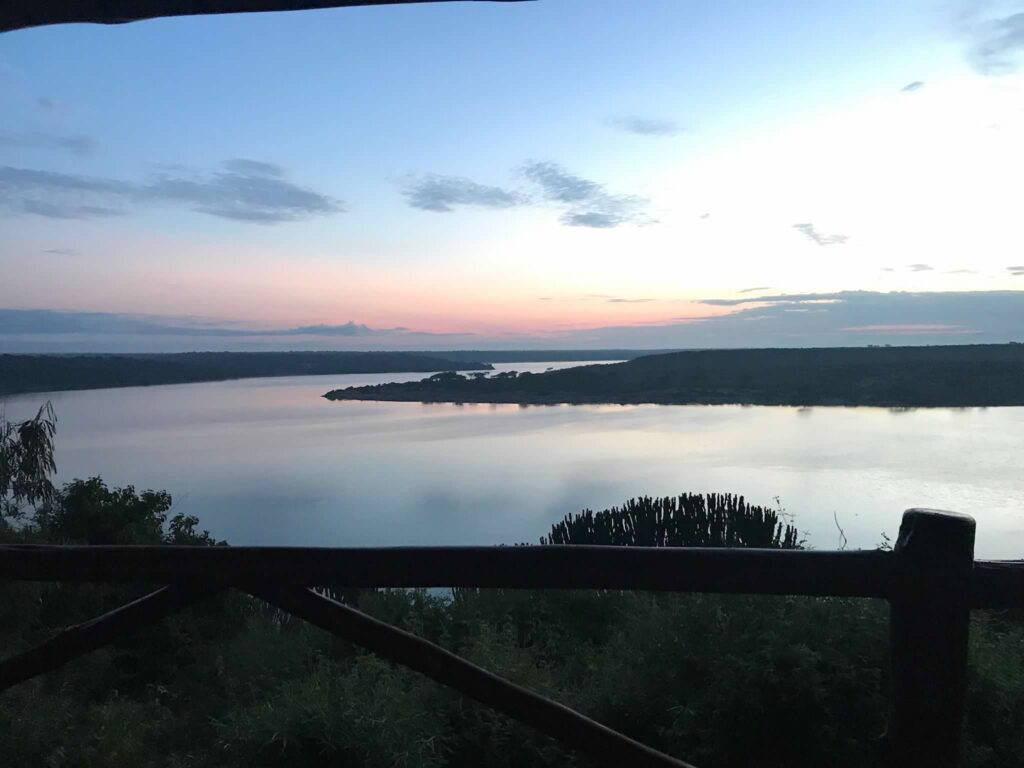

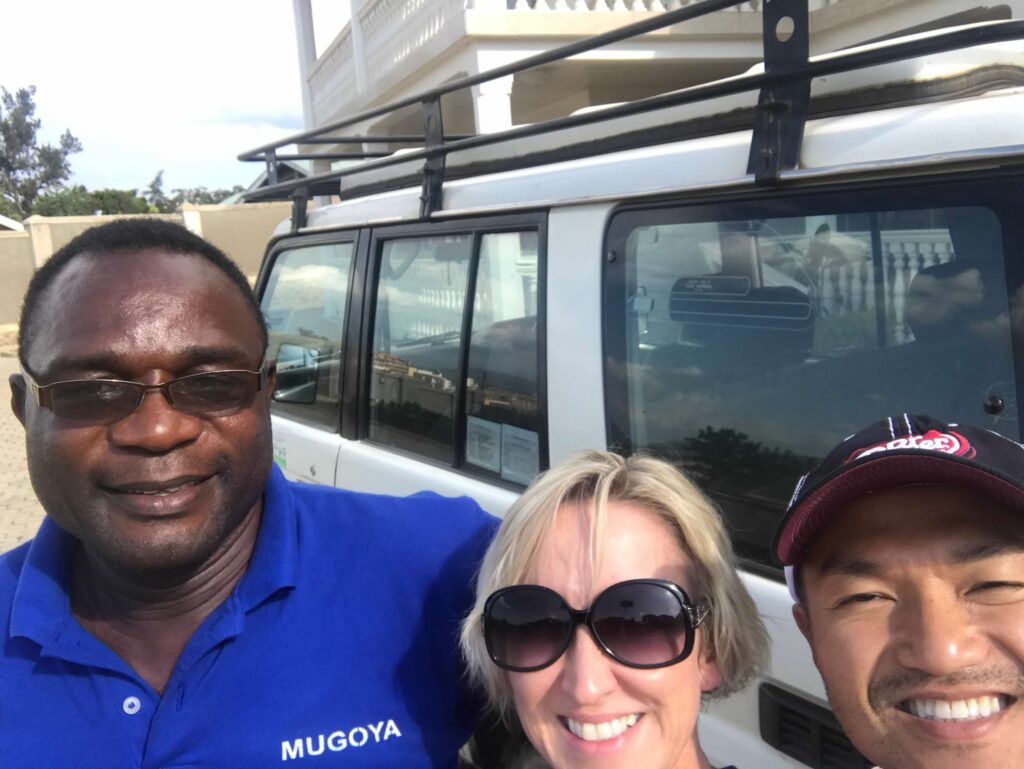

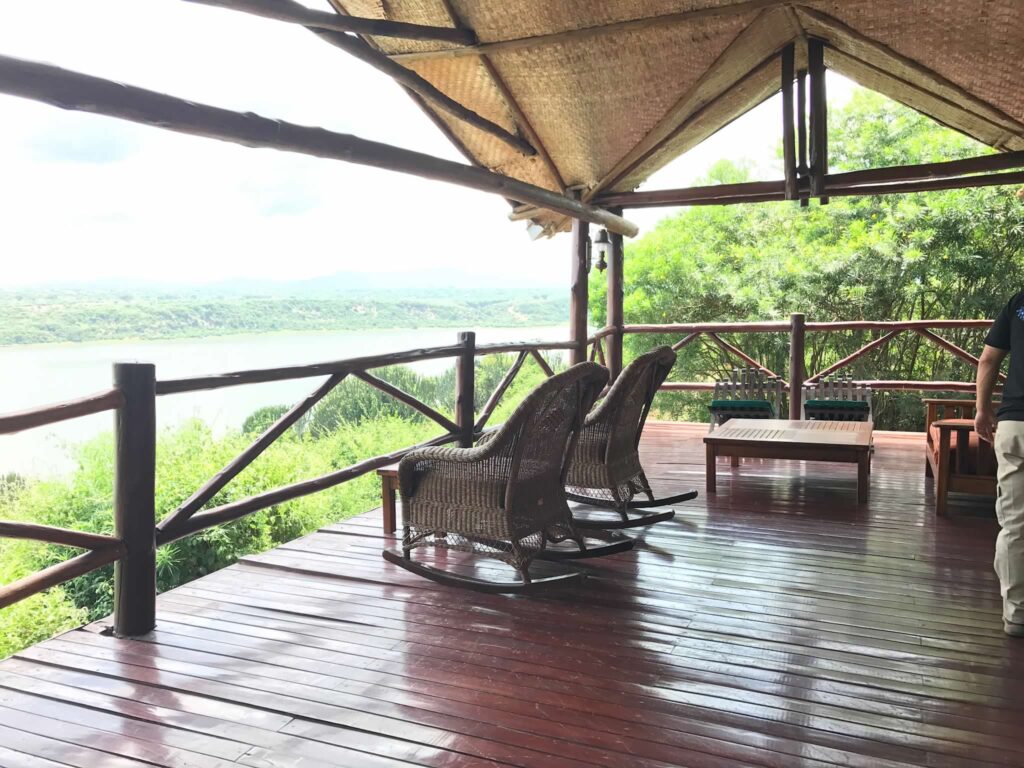

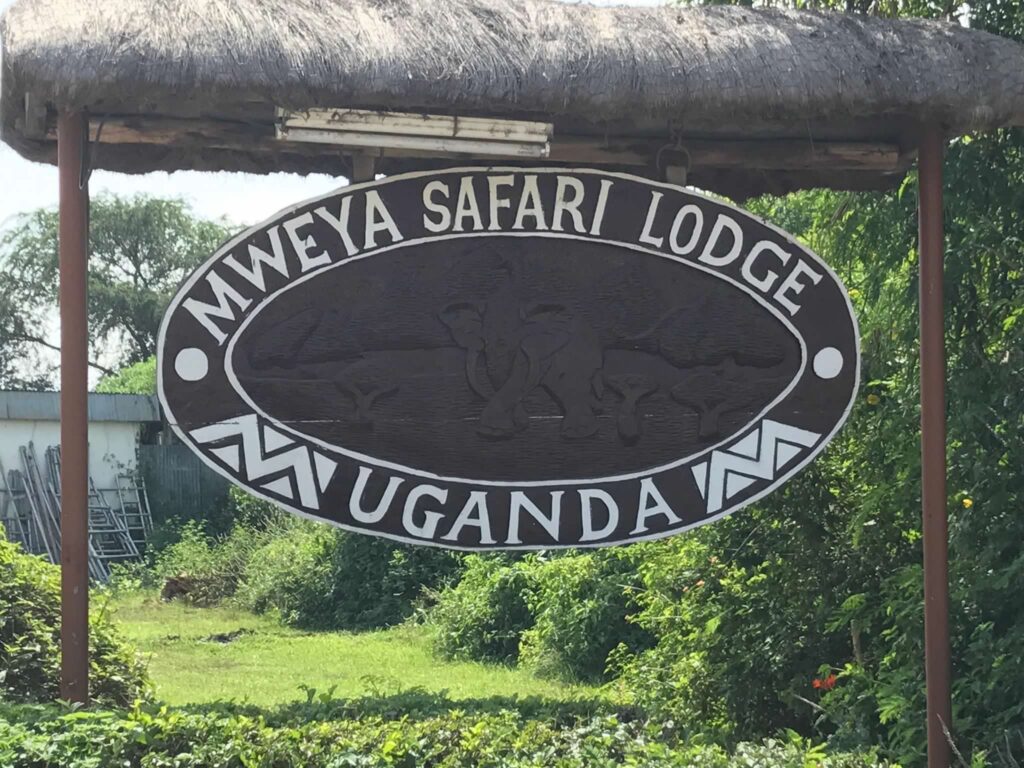

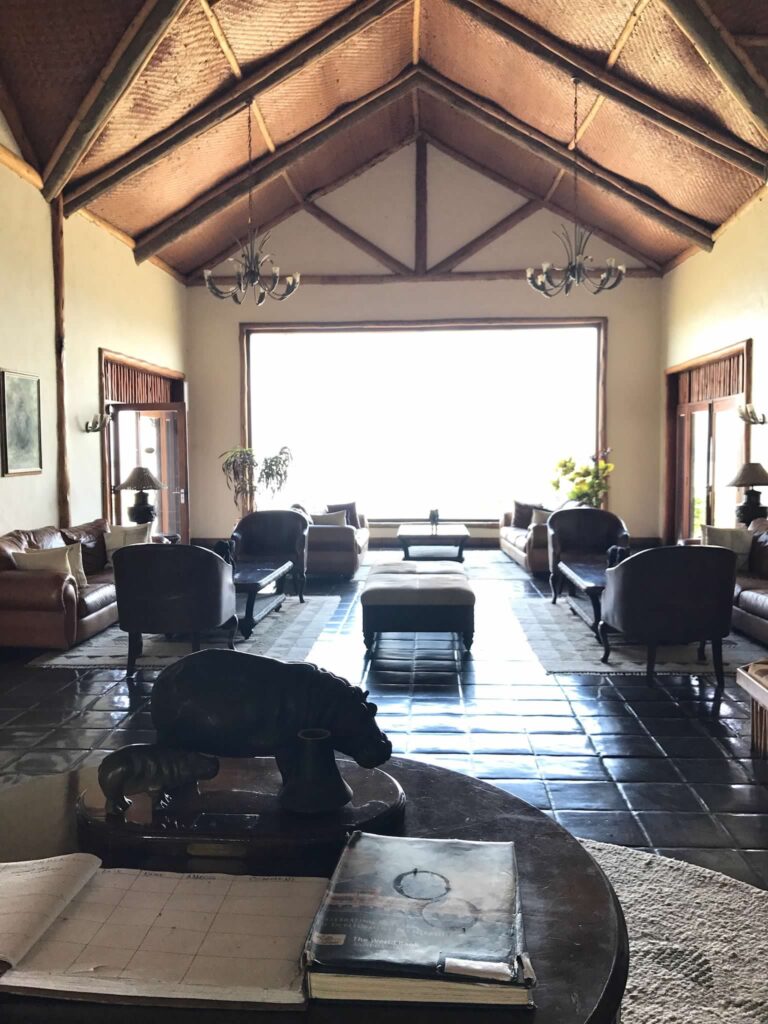

The Lodge and Restaurant
We channeled our inner Hemingway and had drinks at the Tembo Bar. We sat by a window, where our night’s entertainment was watching bats swoop in and eat the flying insects that coated the outside of the window. One bat got inside the bar and wreaked havoc, giving us a fright.
Dinner in the restaurant was a culinary experience. This was the best food we had had in Uganda, and it was really good. We had fish and lamb and a decent bottle of wine, not to mention attentive service.
Game Drive
After coffee in the lodge, we headed out for an early morning game drive. We saw a leopard hanging out in a tree, and more Ugandan Kobs. Birds were the highlight this morning. We saw “red-necked spur fowl” who exhibited some interesting behavior. They stand on top of termite mounds to get a better vantage point. While standing there, they poop out seeds, which is why bushes and candelabra trees grow on top of termite mounds!
Termite mounds can be gigantic! These tall towers of red dirt can grow to soaring heights. According to the Guinness Book of World Records, the largest one ever was found in the Republic of Congo (not to be confused with the Democratic Republic of Congo) and was 42 feet high! However, while researching for this post, I found that an ancient termite megapolis (as large as Britain) with up to 200 million termite mounds as old as 4000 years was recently found in Brazil. Read about that here.
Black headed yellow weavers build spherical nests of grass and sticks that hang from trees like Christmas ornaments and sing a beautiful song. After breakfast, a little relaxation, and lunch, we headed to the dock for our boat tour of Kazinga Channel.
The Three Hour Tour
A Peaceful Boat Ride
We walked down to the pier to board our tour boat, the Hippo, doing our best to ignore the ominous clouds overhead. We made our way to the Kazinga Channel, which connects Lake Edward to Lake George. On one side of the channel, grassy hills ended in sheer cliffs which plunged into the water. Candelabra and acacia trees dotted the hills. We saw tons of wildlife, including elephants, Cape buffalo, stork, and of course, crocodiles and hippos. The cliffs were pockmarked by numerous small holes which housed black and yellow kingfishers. The breeze kept us from overheating, and the clouds prevented the sun from blazing down on us.
Until…
The breeze soon became a hurricane! The sky opened up and we were in the middle of a monsoon! Rain was coming into the boat sideways. Now, I am always prepared. I am obsessed with travel raincoats. But this time, I did not bring them! Suddenly, the boat lurched backward- we had beached on hippo island!
Everyone moved to the front of the boat, but nothing happened. We all gathered in the center of the lower deck and huddled together against the cold rain. We made fast friends with some ladies from the NIH and other couples. Then, we hear a voice barking commands and notice that the captain had come down to our deck wearing his life jacket! We did not have life jackets and had not even been given a safety brief! The captain instructed us to help as he unfurled plastic sheets on the sides of the boat to shield us from the wind, but the boat begin to list heavily to the side and we quickly rolled the plastic back up for fear of capsizing.
Everyone was panicking. We didn’t know what was going to happen or what to do. Disembarking onto the island was not an option because of the hippos and crocodiles. We could hear the hippos snorting and grunting, and even see them peeking ominously out of the water. Death beckoned and my imagination went wild.
The Rescue
At long last, the crew moved us to the back of the boat and somehow un-beached us. We were all very relieved and looking forward to getting back to safety and warmth. Then, we noticed that we were still staying the course! It was still storming, but we were still headed toward Lake George! Several people complained and the Captain finally turned back… no refunds!
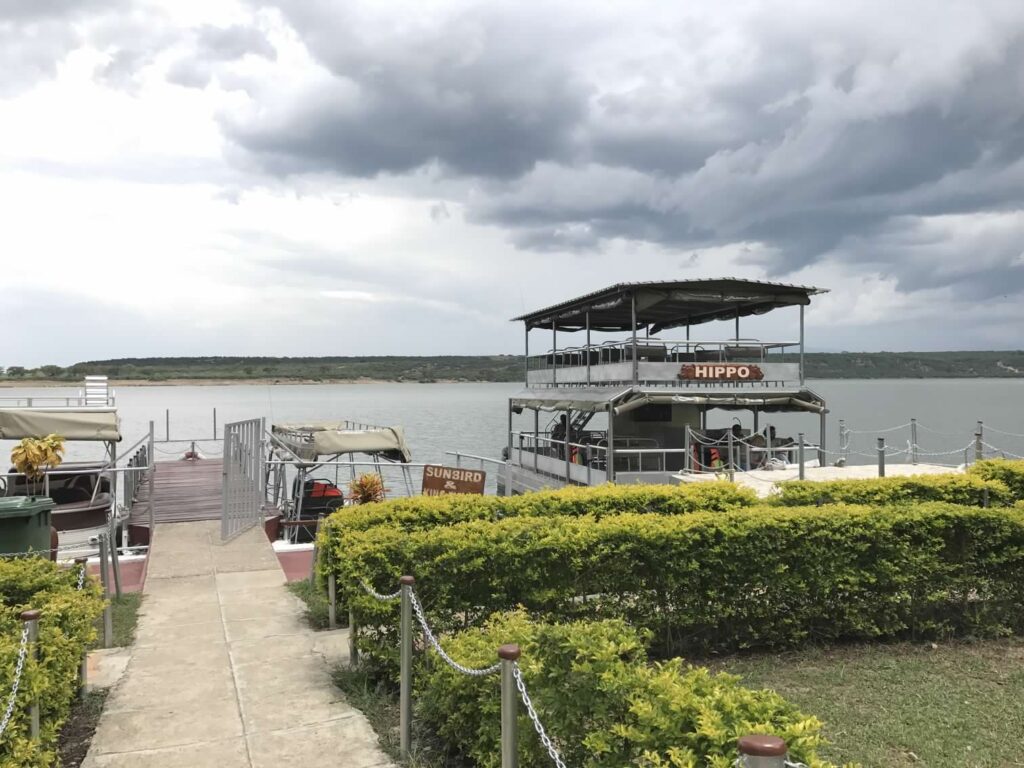

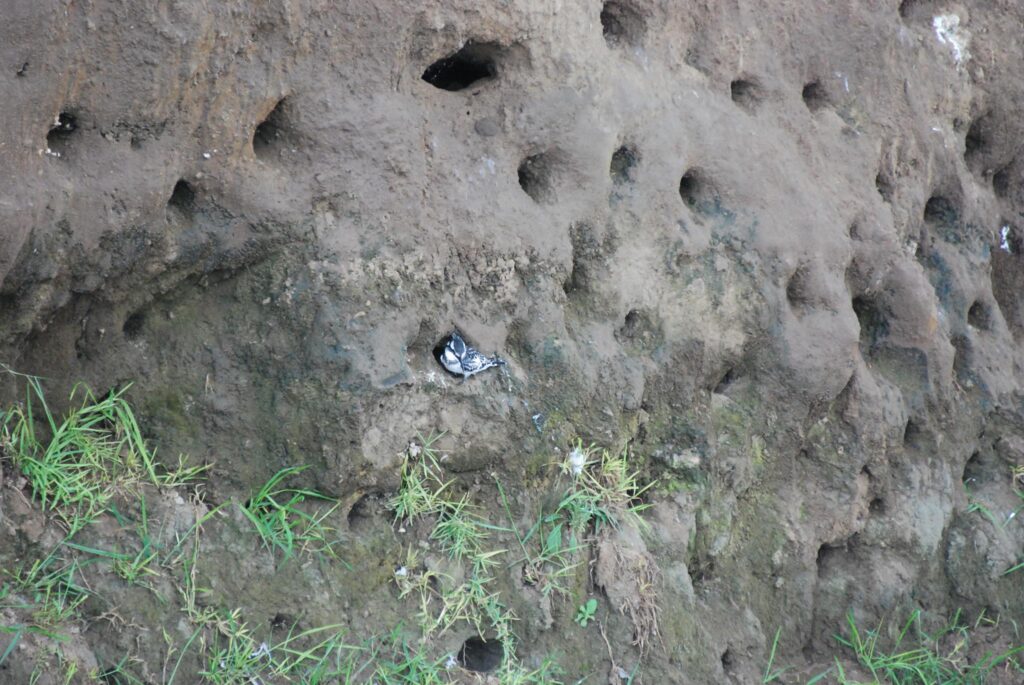

The Lion Hunter
We made it back to shore looking and feeling like drowned rats. Moses Tours had set us up with a scientist to track lions, but we wanted to cancel because we were tired and cold. Our driver, Lucas, and the scientist were already waiting for us in a Land Rover, and they did not offer a refund. So, we decided to go ahead with the tour. We were glad we did!
The Lion Hunter was quite a character, with his elegant British accent and keen, piercing gaze. He wore a ratty pink and brown furry jacket and carried what looked like an old school TV antenna. He stood in the back of the Land Rover with his head and torso sticking out of the top, aiming his antenna in a seemingly random fashion. Vuong and I gave each other wary looks and thought this guy was a fraud and a looney.
A virus had been killing lions in the park, and the scientists needed to figure out a cure. They would shoot the lions with tranquilizer darts and wait for them to pass out. They threw rocks at them to be sure they were asleep, then cautiously approached to place a tracking collar on the animal’s neck. The contraption our scientist carried picked up signals from the tracking collars.
The Drive
We drove around aimlessly for quite a while, then the scientist started barking orders at Lucas, directing him off-road into the savannah grass. We hit unseen potholes and termite mounds, bouncing around to shouts of “hard left” and “turn right!” We avoided the greener areas, as they signified water and we didn’t want to get bogged down.
Suddenly, the Hunter barks “stop!” He quietly tells me to stand up. I do as ordered, and he says “I want you to look at the lions…” I look around skeptically and then I see them! A female lion and her two cubs are sitting in the grass 20 feet to the right of the vehicle! A fresh buffalo carcass is nearby, so close I can smell it, and we watch as the mother teaches her children to tear and eat the meat. A marabou stork comes in and tries to steal a nibble, but she chases him away. A bare tree nearby houses several vultures, patiently waiting their turn.
After a while, we drive on. We encountered a large male lion lounging in a dead candelabra tree, and another beautiful male sunning himself. Vuong was very close to him. He looked into his amber eyes and felt like a mouse.
Moses Tours can set up this experience for you if you visit Queen Elizabeth National Park in Uganda!
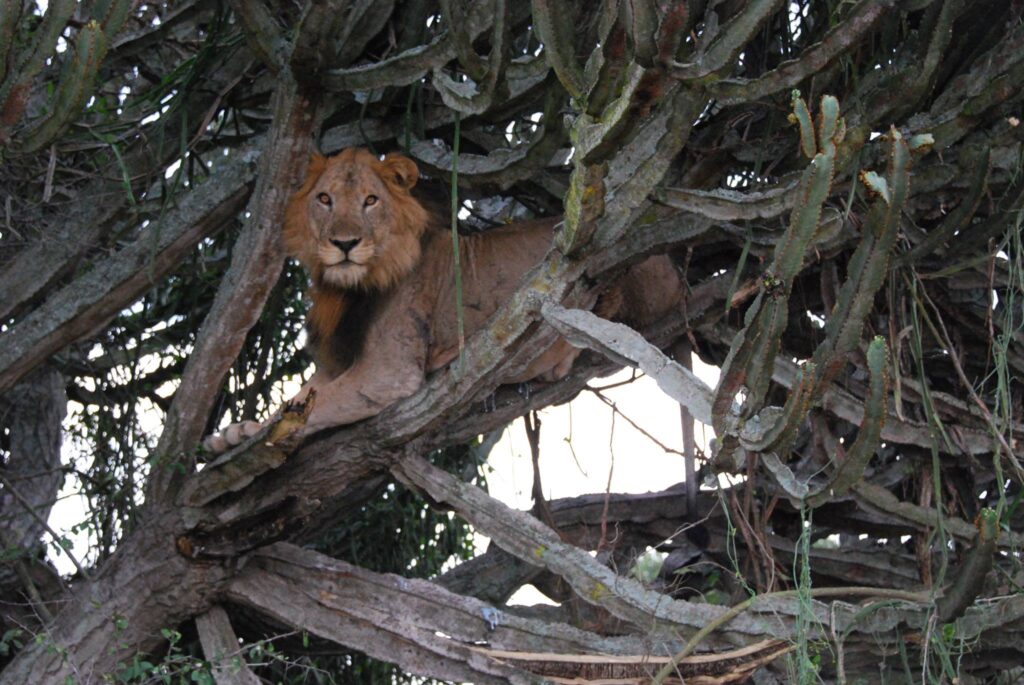

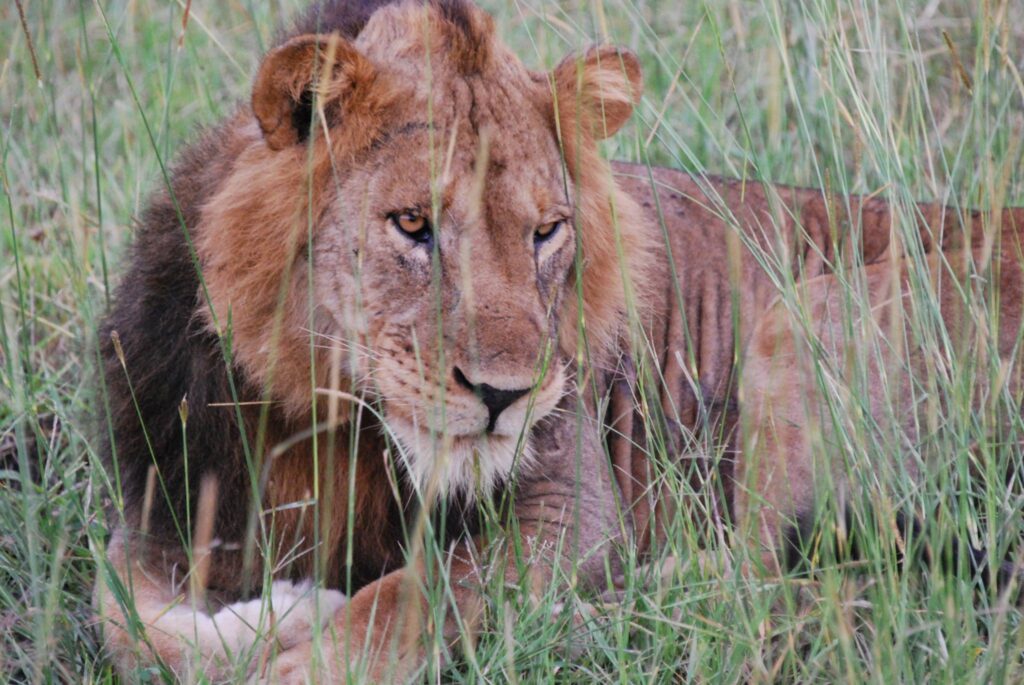

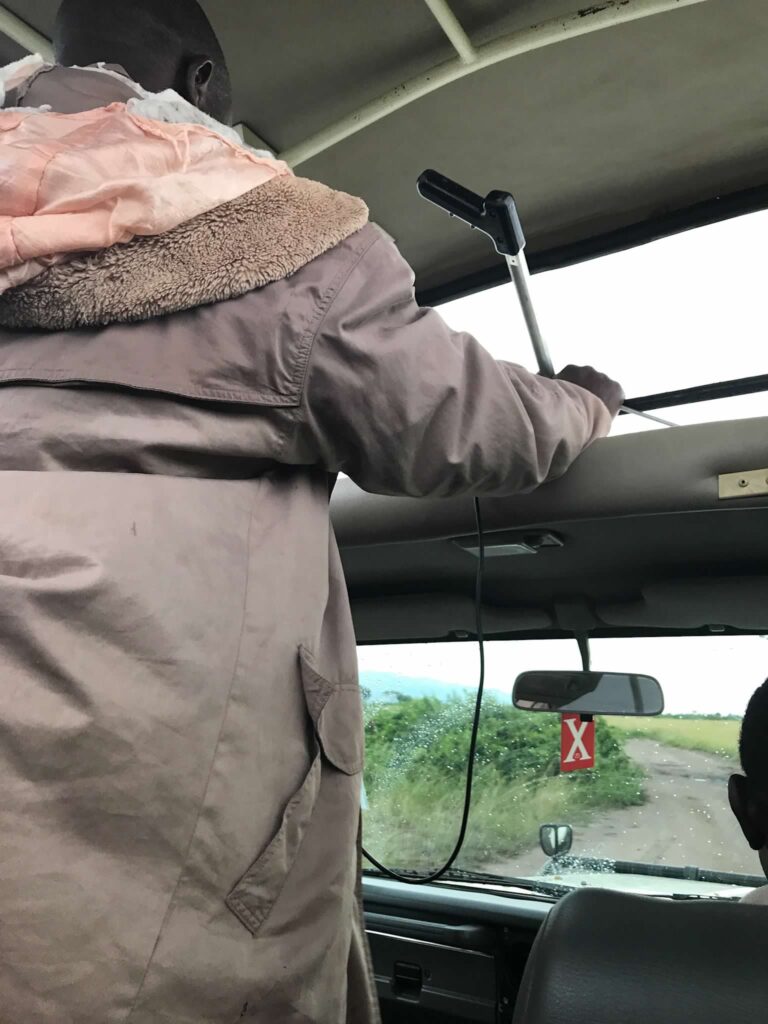

Lake Mburo National Park
After a blissful night’s sleep and leisurely morning, it was time to head back to Mbarara. We took the time to explore Lake Mburo National Park before returning to our temporary home.
Lake Mburo National Park is the smallest National Park in Uganda. It does not have lions or many other predators (just a few serval cats) and as such is one of the few parks where visitors can walk around and get closer to the wildlife. The park boasts numerous wildlife habitats including savannah, forests, and lakes. The park is only about 30 km from Mbarara and makes an excellent weekend getaway. There are numerous lodges to choose from, and many are very affordable.
We spent the day exploring the park and saw mongooses, dazzles of zebra, vervet monkeys, and Ankole cows. Impalas were plentiful, and we were able to get very close to them. We saw waterbuck, tope, and occasional eland. Elands are the largest antelopes and are roughly cow-sized, with tawny fur and white stripes.
We really enjoyed watching the warthogs! They were everywhere, with their tiny, adorable piglets. The adults run fast through the grass, with their tails held high so their babies can keep track of them and follow.
We took a walk with a park ranger and encountered a group of about 15 giraffe. You really realize how tall they are when you are on the ground near them! They are lanky, yet graceful, lazily munching leaves from the tops of the trees. I looked back and there was a giraffe watching us, inching closer and closer. I imagined this was a curious teenage male, straying from the tower (this is the name of a group of giraffes) to see what strange creatures were lurking about.
If you have the time, stop by Lake Mburo! The density of wildlife makes for a really fun game drive, and their rangers are friendly and knowledgeable!
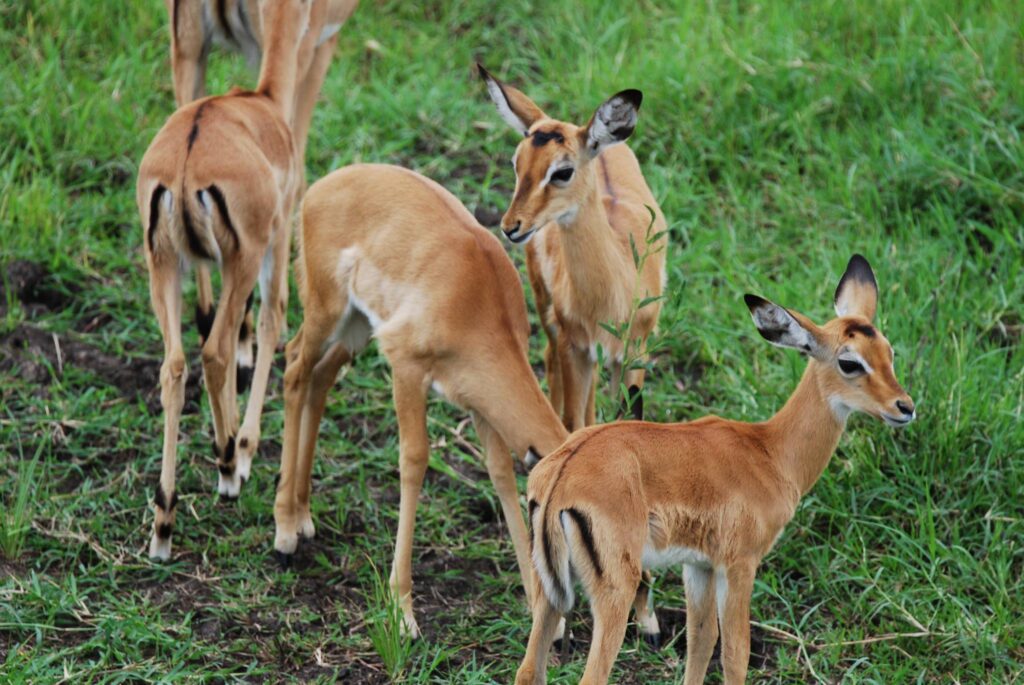

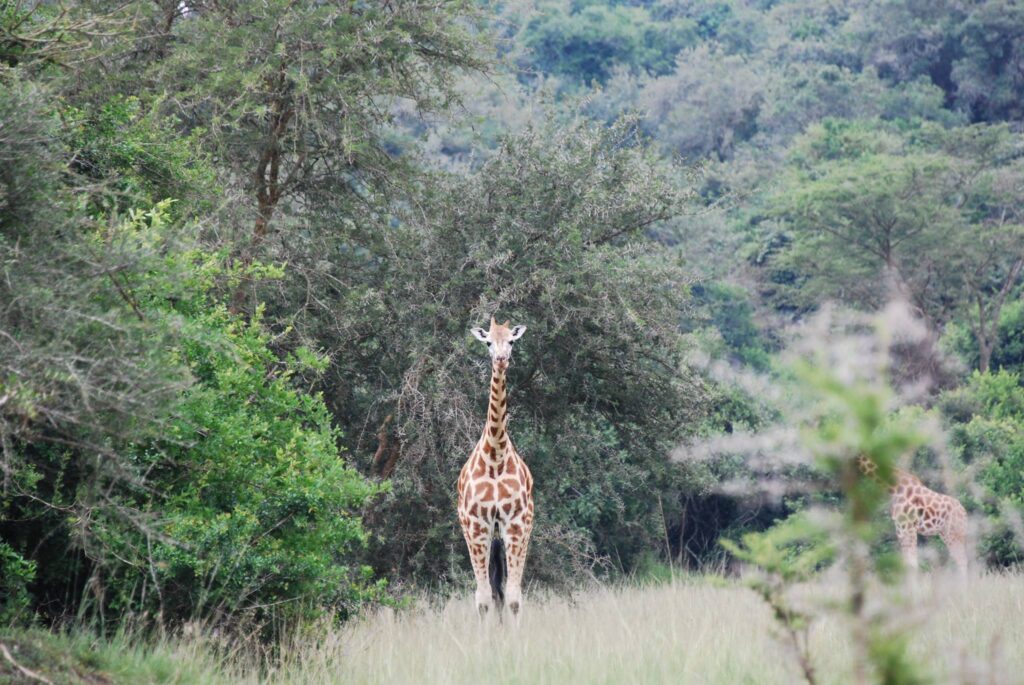

The End
Our time in Uganda, the Pearl of Africa, came to an end. This trip was truly transformative, and we made a few life long friends. Hopefully, we helped a bit, and we certainly learned a lot and enjoyed seeing this beautiful place.
Come back next time for details about our trip to Zanzibar! We arranged for a few nights on this Tanzanian island to relax before heading home. Zanzibar is one of my favorite places on earth and I highly recommend visiting!
